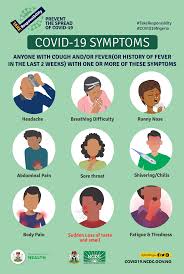Having any of these other symptoms or the classic ones, either alone or in combination, was associated with infection with the coronavirus and the more symptoms people show the more likely they are to test positive, the researchers warn.
Swab tests and questionnaires were collected between June 2020 and January 2021 for the study, the researchers say.
More importantly, the study found that there was variation in symptoms with age.
For instance, while chills were linked with testing positive across all ages, headaches were reported in young people aged five to 17; appetite loss in 18-54 and 55+, and muscle aches in people aged 18-54.
Again, the study says infected five to 17-year-olds were less likely to report fever, persistent cough and appetite loss, compared with adults.
Director of the REACT programme at Imperial, Prof. Paul Elliott, said: “These new findings suggest many people with COVID-19 won’t be getting tested – and therefore won’t be self-isolating – because their symptoms don’t match those used in current public health guidance to help identify infected people.
“We understand that there is a need for clear testing criteria, and that including lots of symptoms which are commonly found in other illnesses like seasonal flu could risk people self-isolating unnecessarily.
“I hope that our findings on the most informative symptoms mean that the testing programme can take advantage of the most up-to-date evidence, helping to identify more infected people.”
Another researcher, Dr. Joshua Elliott from Imperial College London’s School of Public Health, submits that, “As the epidemic progresses and new variants emerge, it’s essential that we keep monitoring how the virus affects people so that testing programmes [can] meet changing needs.”
He expressed the hope that the data will help to inform testing guidance and the development of systems that could help better identify people who should take a COVID-19 test based on their symptoms.
source: Punch

 A study by scientists at Imperial College London suggests that the manifestation of COVID-19 symptoms vary with age. The study, published online and undertaken by the Imperial College London-led REACT, shows that among other COVID-19 symptoms, chills, loss of appetite, headache and muscle aches were together most strongly linked with being infected, alongside the four classic symptoms such as loss of sense of taste, loss of sense of smell, fever, new persistent cough.
A study by scientists at Imperial College London suggests that the manifestation of COVID-19 symptoms vary with age. The study, published online and undertaken by the Imperial College London-led REACT, shows that among other COVID-19 symptoms, chills, loss of appetite, headache and muscle aches were together most strongly linked with being infected, alongside the four classic symptoms such as loss of sense of taste, loss of sense of smell, fever, new persistent cough.




